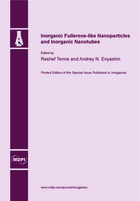Inorganic Fullerene-like Nanoparticles and Inorganic Nanotubes
A special issue of Inorganics (ISSN 2304-6740). This special issue belongs to the section "Inorganic Solid-State Chemistry".
Deadline for manuscript submissions: closed (15 March 2014) | Viewed by 86702
Special Issue Editors
Interests: nanoparticles synthesis; solid state chemistry; characterization of nanoparticles
Special Issues, Collections and Topics in MDPI journals
Special Issue Information
Dear Colleagues,
Inorganic fullerene-like nanoparticles and inorganic nanotubes represent a relatively new type of condensed matter. They are constructed from non-carbon layers that are folded into tubular, polyhedral or quasi-spherical shells. This combination of low dimensionality and nano-size can enhance the layered compounds’ performance in their already known applications, as well as in new fields of use. The production of inorganic hollow nanoparticles initially arose in the 1990’s from a fortuitous lab discovery of a great number of fullerenic and nanotubular chalco- and halogenides. Commercial production of said particles now focuses on molybdenum and tungsten disulfides; tons per year are currently synthesized. MoS2 and WS2 are well established dry lubricants. The tribological characteristics and stability of these lubricants can be considerably enhanced by taking advantage of fullerene-like morphologies. Moreover, nanotubes and fullerene-like MoS2 and WS2 can be functionalized so as to transfer their excellent properties to oil-based lubricants and wear-resistant surface coatings, thus pushing ahead the large-scale use of layered sulfides in the machinery, aerospace, and medical industries. Apart from tribological qualities, the significant stability of sulfide fullerene-like nanoparticles and nanotubes under shock-wave propagation suggests their potential as fillers for impact resilient polymer or ceramic composites.
Substantial progress in the warrantable production and pioneering use of this kind of inorganic nanomaterials was possible due to comprehensive basic research on their formation mechanism, chemical reactivities, and mechanical and electronic characteristics. However, current experimental work has rapidly advanced in the direction of targeted functionalization of the nanoparticles using doping, intercalation, surface modification by molecules, endohedral sealing. Furthermore, various polymer nanocomposites containing minute amounts of these nanoparticles were shown to exhibit enhanced mechanical properties (reinforcement).The optical and electronic transport properties have been recently studied in some cases. Although the primary emphasis has been placed on molybdenum and tungsten disulfide species, the mass fabrication of BN nanotubes and the potential strategies for extended production of various other fullerene-like nanoparticles (BN, ReS2, LnF3 etc.) has also been demonstrated. Novel and modified nanoparticles can provide for a much larger diversity of new nanomaterials in catalysis, electronics and electrochemistry; however, the detailed characterization of such particles is required. Despite some success in the description of polyhedral fullerenes’ construction principles, understanding the morphology of fullerene-like nanoparticles at the atomistic level is still a challenge from both theoretical and experimental perspectives. The exact formation mechanisms, the interface phenomena, along with the details of mechanical destruction of the inorganic hollow nanoparticles under load, are still poorly described or remain unknown in most of the cases.
Therefore, this special issue welcomes comprehensive reviews and research articles to collect the widest information available to date in the field of inorganic fullerene-like nanoparticles and nanotubes.
Prof. Dr. Reshef Tenne
Dr. Andrey N. Enyashin
Guest Editors
Manuscript Submission Information
Manuscripts should be submitted online at www.mdpi.com by registering and logging in to this website. Once you are registered, click here to go to the submission form. Manuscripts can be submitted until the deadline. All submissions that pass pre-check are peer-reviewed. Accepted papers will be published continuously in the journal (as soon as accepted) and will be listed together on the special issue website. Research articles, review articles as well as short communications are invited. For planned papers, a title and short abstract (about 100 words) can be sent to the Editorial Office for announcement on this website.
Submitted manuscripts should not have been published previously, nor be under consideration for publication elsewhere (except conference proceedings papers). All manuscripts are thoroughly refereed through a single-blind peer-review process. A guide for authors and other relevant information for submission of manuscripts is available on the Instructions for Authors page. Inorganics is an international peer-reviewed open access monthly journal published by MDPI.
Please visit the Instructions for Authors page before submitting a manuscript. The Article Processing Charge (APC) for publication in this open access journal is 2700 CHF (Swiss Francs). Submitted papers should be well formatted and use good English. Authors may use MDPI's English editing service prior to publication or during author revisions.







